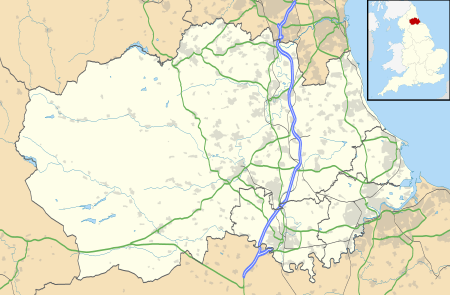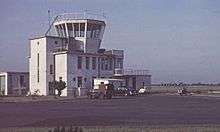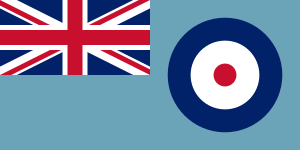RAF Middleton St George
RAF Middleton St. George was a Royal Air Force (RAF) Bomber Command station during World War II. It was located in County Durham, five miles east of Darlington, England. The stations' motto was Shield and Deter.[1]
RAF Middleton St. George | |||||||||||||||||||
|---|---|---|---|---|---|---|---|---|---|---|---|---|---|---|---|---|---|---|---|
 A crew of No. 78 Squadron RAF watch as engine adjustments are made to an Armstrong Whitworth Whitley bomber, Z6743, before they take off for a raid from Middleton St George. | |||||||||||||||||||
| Summary | |||||||||||||||||||
| Airport type | Military | ||||||||||||||||||
| Owner | Air Ministry | ||||||||||||||||||
| Operator | Royal Air Force Royal Canadian Air Force | ||||||||||||||||||
| Location | Middleton St. George | ||||||||||||||||||
| Coordinates | 54°30′33″N 001°25′46″W | ||||||||||||||||||
| Map | |||||||||||||||||||
 RAF Middleton St. George Location in County Durham | |||||||||||||||||||
| Runways | |||||||||||||||||||
| |||||||||||||||||||

History
Second World War
Like many similar airfields; RAF Middleton St George was commissioned in 1938 in anticipation of WWII and opened in 1941 under the auspices of Bomber Command. Contrary to popular belief the airfield was never called RAF Goosepool, Goosepool being the name of the farm which made way for the airfield, with the name sticking amongst the local population. In 1943 it was allocated to No. 6 Group, Royal Canadian Air Force.[2] A sub-station was located at RAF Croft, Yorkshire.[3] Squadrons based here include: 76 Squadron, which flew Handley Page Halifaxes, 78 Squadron, which flew Armstrong Whitworth Whitleys, 419 Squadron RCAF, which flew Vickers Wellingtons, Halifaxes, and Avro Lancasters, 420 Squadron RCAF, which flew Wellingtons, and 428 Squadron RCAF, which flew Wellingtons, Halifaxes, and Lancasters.[4]
Andrew Mynarski, a member of 419 Squadron RCAF at Middleton St. George, was posthumously awarded the Victoria Cross. It was bestowed for his actions on 13 June 1944, in a raid on Cambrai, France, in support of the Normandy landings. A statue of Mynarski was dedicated in 2005 outside the former Officers' Mess.
A memorial garden for all aircrew at Middleton St. George is also located near the Mess.[5]
Post war
After the war, the aerodrome served various squadrons and units including No. 13 Operational Training Unit (OTU), No. 2 Air Navigation School, No. 4 Flying Training School, and squadrons that used Gloster Meteors, Hawker Hunters, Gloster Javelins and English Electric Lightnings.[6] In 1947, the airfield became a satellite station of RAF Leeming, North Yorkshire.[7]
In 1962 Flying Officer Jean Oakes became the first woman to fly at over 1,000 mph. The London Times of 14 September 1962 reported that from RAF Middleton St George, she took over the controls from Flight Lieutenant John Smith and flew up and down the north east coast at about 1.6 mach.
The RAF left the station in 1964, but the aerodrome was reopened in 1966 as a civil airport.[8] The airfield was named Teesside International Airport in the 1960s, and was renamed Durham Tees Valley Airport in 2004.[9] In the late 1980s the entire Married Quarter housing estate was sold to Roger Byron-Collins' company the Welbeck Estate Group and following all the housing being upgraded it was reopened by the local Mayor naming it The Virginia Estate after Welbeck's USA office in Arlington Virginia.[10]
From 1968 to 1979, some of the former station buildings housed Middleton St George College of Education, a teacher training college.[11]
The officers' mess at the base was converted into the St George Hotel, complete with the RAF Middleton St George museum. The hotel was mothballed in late 2018, the museum is to be relocated in the future.[12][13]
Units and aircraft
| Unit | Dates | Aircraft | Variant | Notes |
|---|---|---|---|---|
| No. 33 Squadron RAF | 1958–1962 | Gloster Javelin | FAW.7 and FAW.9 from 1960 | Twin-engined jet fighter/interceptor.[14] |
| No. 76 Squadron RAF | 1941–1942 | Handley Page Halifax | Mks.I and II | Four-engined piston heavy bomber.[15] |
| No. 78 Squadron RAF | 1941 | Armstrong Whitworth Whitley | Mk.V | Twin-engined medium bomber.[15] |
| 1942 | Handley Page Halifax | Mk.II | Four-engined piston heavy bomber.[15] | |
| No. 92 Squadron RAF | 1957 1958-1960 | Hawker Hunter | F.6 | Single-engined jet fighter/fighter-bomber.[16] |
| No. 264 Squadron RAF | 1957 | Gloster Meteor | NF.14 | Twin-engined jet night-fighter.[17] |
| No. 419 Squadron RCAF | 1942–1944 | Handley Page Halifax | Mk.II | Four-engined piston heavy bomber.[18] |
| 1944–1945 | Avro Lancaster | Mk.X | Four-engined piston heavy bomber.[18] | |
| No. 420 Squadron RCAF | 1942–1943 | Vickers Wellington | Mks.III and later X before move to North Africa | Twin-engined medium bomber.[18] |
| No. 428 Squadron RCAF | 1943–1944 | Handley Page Halifax | Mks.V and II | Four-engined piston heavy bomber.[18] |
| 1944–1945 | Avro Lancaster | Mk.X | Four-engined piston heavy bomber.[18] |
- 1947-1948 No. 13 Operational Training Unit RAF de Havilland Mosquito Mk.T3 & Mk 6.
- 1951-1953 No. 205 Advanced Flying School RAF Gloster Meteor Mk7 & Mk 8.[19]
- 1963-1964 No. 226 Operational Conversion Unit RAF English Electric Lightning[20]
References
Citations
- Pine, L.G. (1983). A dictionary of mottoes (1 ed.). London: Routledge & Kegan Paul. p. 212. ISBN 0-7100-9339-X.
- "Stations-M". www.rafweb.org. Retrieved 4 November 2017.
- Halpenny 1982, p. 54.
- Delve 2006, p. 197.
- Middleton St George Memorial Association: http://www.middleton-st-george-memorial-association.org/ ; The Wartime Memories Project: "RAF Middleton St. George During the Second World War." https://wartimememoriesproject.com/ww2/airfields/airfield.php?pid=1804
- Halpenny 1982, pp. 149–150.
- Coupland, Peter (1997). Straight and True. Barnsley: Pen and Sword. p. 61. ISBN 0-85052-569-1.
- Halpenny 1982, pp. 150–151.
- Lloyd, Chris (24 January 2015). "Getting airborne at Middleton St George 50 years ago". The Northern Echo. Retrieved 4 November 2017.
- https://www.twsg.co.uk/
- Reunion website
- "A Brief History of Middleton St George from 1800" (PDF). Middleton-st-george.org. p. 11. Retrieved 2 June 2018.
- Teesside Live Website | [url=https://www.gazettelive.co.uk/news/teesside-news/everything-must-go-entire-contents-15542008
- Jefford 1988, p. 36.
- Jefford 1988, p. 48.
- Jefford 1988, p. 52.
- Jefford 1988, p. 80.
- Jefford 1988, p. 91.
- Wilson, Keith (2015). RAF in camera 1950s. Barnsley: Pen & Sword. p. 111. ISBN 978-1-4738-2795-0.
- "Middleton St. George (Durham Tees Valley) - Airfields of Britain Conservation Trust UK". www.abct.org.uk. Retrieved 4 November 2017.
Bibliography
- Delve, Ken (2006). The Military Airfields of Britain, Northern England: Co. Durham, Cumbria, Isle of Man, Lancashire, Merseyside, Manchester, Northumberland, Tyne & Wear, Yorkshire. Marlborough: Crowood Press. ISBN 1-86126-809-2.
- Halley, James J. (1988). The Squadrons of the Royal Air Force & Commonwealth, 1918-1988. Tonbridge, Kent, UK: Air-Britain (Historians) Ltd. ISBN 0-85130-164-9.
- Halpenny, Brue Barrymore (1982). Action Stations 4; Military Airfields of Yorkshire. Cambridge: Patrick Stephens ltd. ISBN 0-85059-532-0.
- Jefford, C G (1988). RAF Squadrons. A comprehensive record of the movement and equipment of all RAF squadrons and their antecedents since 1912. Shrewsbury: Airlife. ISBN 1-85310-053-6.
- Moyes, Philip J.R. (1976). Bomber Squadrons of the RAF and their Aircraft. London: Macdonald and Jane's (Publishers) Ltd. ISBN 0-354-01027-1.
External links
| Wikimedia Commons has media related to RAF Middleton St. George. |
